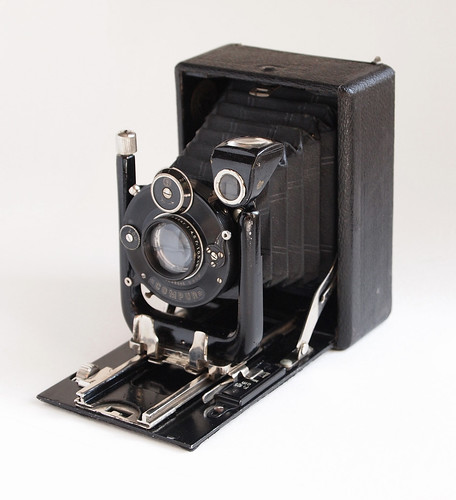 |
| Glunz Model 0 |
When this small wooden-bodied folding camera arrived in the post, a speculative purchase, there was almost nothing on the camera to identify it, save a small badge inside the body. This has a monogram reading
G&S Kamerawerk Hannover-List. This was enough information to turn up some references to Glunz & Sohn Kamerawerk, but there is very little online about the company - the
Glunz page on Camera-Wiki is very sparse for example (and I created the
Glunz Mod. 0 page on Camera-Wiki myself, and it has only had three minor edits in the five years since). On
Collection-Appareils I found a
Glunz & Sohn Model 0 camera which looked very much like my version, although not identical - but also more recent, from the 1930s. The serial numbers on the lens and shutter belonging to my camera date them to c.1919. The Model 0 name appears to be a back formation from Glunz's 9x12cm Model 1, presumably produced first, and possibly not named Model 1 when first produced -
or it could indicate Glunz's most basic model camera.
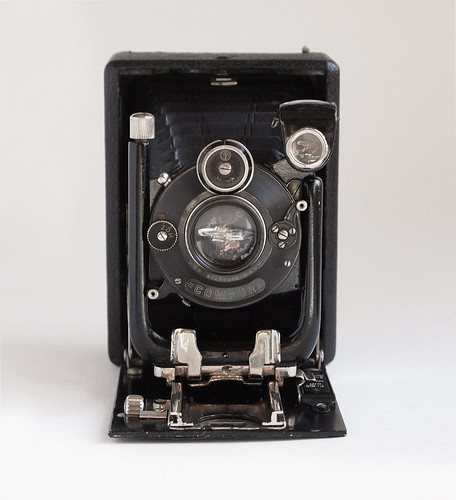 |
| Glunz Model 0 |
The camera is very simply constructed with very few extraneous features. There's no handle on the body, as most folding plate cameras of this type would ordinarily possess. The bellows are single extension only, and there's only a rotating brilliant finder for framing - many other cameras would also have a frame finder; the brilliant finder doesn't have a spirit level attached either. It does however have rise and cross front movements: these seem pretty standard on these pre-war cameras, the movements seen as essential - perhaps converging verticals were distressing to the photographers of the day. The front cross movement is just by friction, while the rise has a standard worm screw. Focus is by ground glass screen, using rack and pinion, with a lock by pushing in the focus knob. The camera also has a scale on the folding bed, which also has an infinity lock, a small lever which pushes in to release the lens standard to advance it further on its rails. There are tripod sockets for vertical and horizontal images.
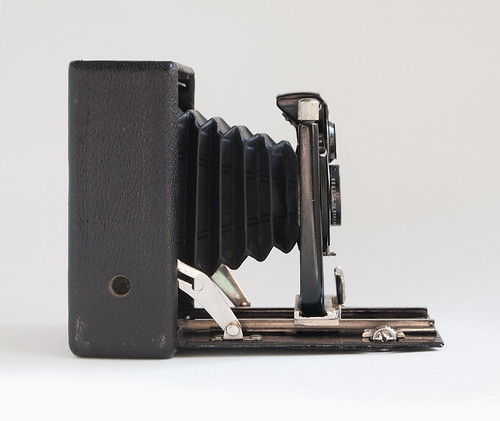 |
| Glunz Model 0 |
The Mod. 0's body is made from wood with the drop bed (and lens standard) in aluminium. The oddity of the camera is that despite being made very simply, cheaply, and with very few features, it has what would have been a top of the range lens and shutter combination: a 10.5cm f4.5 Tessar lens (fast for its time) in a dial-set Compur shutter. These were of course bought-in stock items, but for a camera this simple, one might expect a cheaper triplet lens in a Gauthier or other shutter - such as seen on the catalogue pages reproduced on
Collection-Appareils. That the shutter function dial has ZDM (Zeit, Dauer, Moment) strongly suggests that this particular model of the camera was destined for the German home market, rather than using TBI (Time, Bulb, Instant) for export. The presence of the Tessar lens in the Compur shutter may mean that the camera's model number may in fact not be the Model 0; it's possible that with the same body, the Glunz's model numbers may actually indicate the lens/shutter options. However, there isn't enough information online to be sure that this may in fact be the case.
 |
| 6.5x9cm plateholders from A.P. Paris |
The Model 0 takes very different plateholders from other 6.5x9cm plate cameras I've used. The camera came with six plateholders, all stamped with A.P. Paris, but of two different designs - three have fabric tabs which appear to be there to make removing the plateholders from the camera easier (other plateholders sometimes have a small indent at the bottom for this). The plate holders are of a block-edge type, without the single or double lip around the holders that seems to be far more common. This means that none of the many other plateholders I have can be used with the camera, nor can I use the Rada rollfilm back with the Model 0. The ground glass screen itself is made from a plateholder; whether this was original is open to question, but the conversion was done very skillfully, unlike some I have seen. This is of the same design as the holders with the fabric tabs, although the tab here is cut off level with the metal (the stamp A.P. Paris is in a different place, compared to the proper plateholders though). The body has a small locking lever to secure the plateholder once inserted for removing the darkslide.
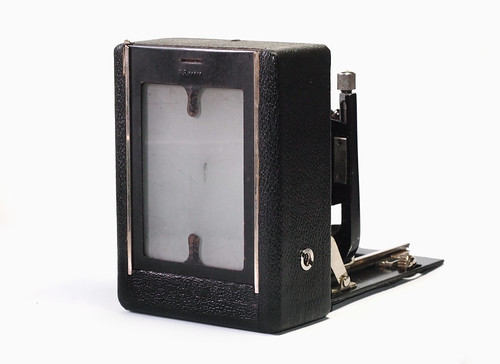 |
| Glunz Model 0 ground glass screen |
The ground glass screen does not have a hood attached (and doesn't look like it ever had one); I generally don't use a dark cloth when shooting old plate cameras hand-held, and the lack of a hood does make it difficult to see an image of any clarity on the screen. Apart from a few longer exposures, I shot most of the plates shown on this post hand-held. I shot a few plates when I first acquired the camera, but then didn't really use the camera until more recently - partly due to the lack of plateholders.
 |
| Glunz Mod. 0 with Ilford HP3 plate - test exposure |
Having just six of these has been limiting in terms of taking the camera out to shoot - unless one is prepared to take a dark bag and spare plates. I've also used paper and sheet film with the camera, but in an equally limiting fashion, having just one 6.5x9cm film sheath.
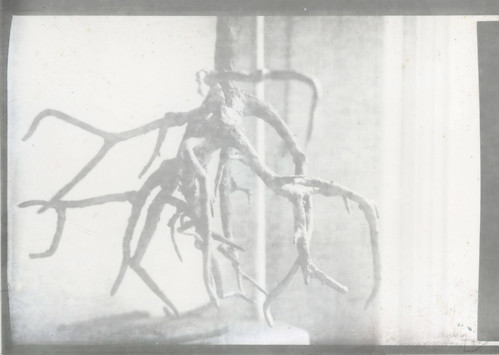 |
| Glunz Mod. 0 with Harman Direct Positive Paper |
 |
| Glunz Mod. 0 with Ilford HPS glass plate |
In practice, the Glunz Model 0's construction makes for a light plate camera, partly thanks to its lack of features, which would all add weight, and only having six holders to carry around with it does not add much. The camera doesn't look like it was used very much during its earlier life. The dial-set Compur shutter is in excellent condition, and fires pretty accurately at all speeds, even the slower ones. The Tessar lens is what one would expect, as a pre-war lens, it's not coated but the results are perfectly acceptable. One problem with the camera is that the two arms holding the folding bed do not securely lock out once the camera is opened- these aren't sprung like they are on other cameras I have, and it's very easy to knock the folding bed back, putting the lens standard out of true with the film plane. Although the camera has single extension bellows, in practice its possible to rack the lens standard out to the very edge of the lens board, enabling close focus to around 40cm - as with the HP3 plate shot of the raspberry canes below.
Apart from the shot on Agfapan APX 100 and that on Harman Direct Positive Paper, the rest of the photographs on this post shot with the Glunz Model 0 are on glass plates from the 1950s and 1960s. Most of the Ilford plates have aged fairly well (some of the
Kodak plates less so); the Special Lantern plates would have been very slow originally, but weren't intended for 'pictorial contrast', instead these were designed for making lantern slides by contact - or just conceivably via and enlarger - so have a very slow blue-sensitive emulsion (generally, the slower the emulsion speed, the less it is affected by age). However, I also shot some Ilford HPS plates, which came from a box with a leaflet dated to 1952; HPS was the fastest emulsion available at the time - 400 ASA (pre-1960, so 800 by today's standards) and these plates came out well, rating them well below box speed to compensate for age.
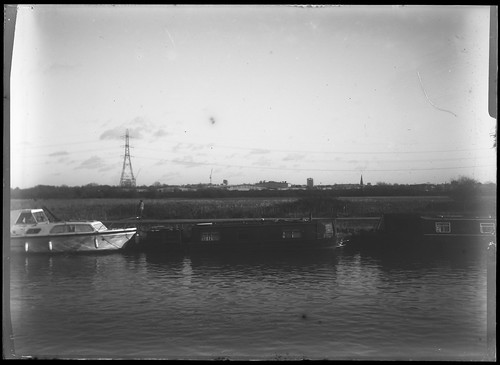 |
| Glunz Model 0 with Ilford Special Lantern Plate |
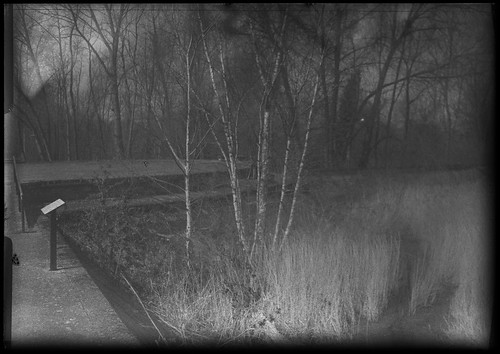 |
| Glunz Model 0 with Kodak P1600 Panchro-Royal glass plate |
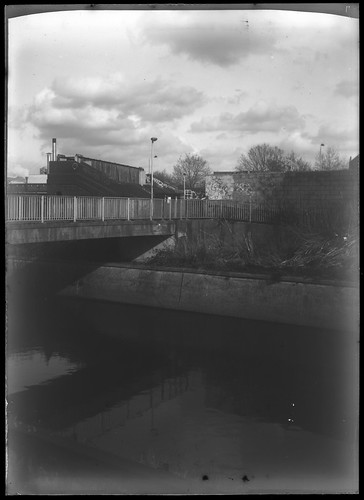 |
| Glunz Model 0 with Ilford Special Lantern Plate |
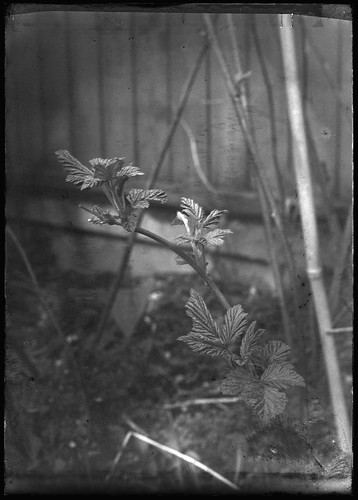 |
| Glunz Model 0 with Ilford HP3 glass plate |
 |
| Glunz Model 0 with Ilford HPS glass plate |
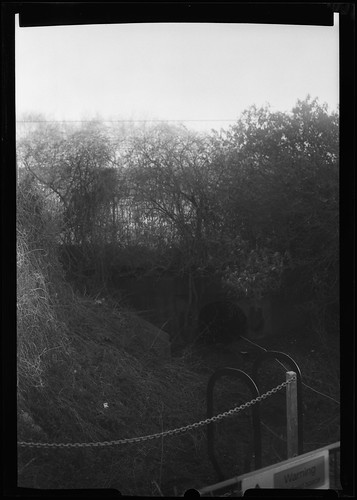 |
| Glunz Model 0 with Agfapan APX100 sheet film |
Sources/further reading:
Glunz & Sohn on Camera-Wiki
Glunz Model 0 on Camera-Wiki
On Collection Appareils (French)














What a little gem of a camera. Very interesting to see your plate work, as I’m just about to embark on some 4x5 plate photography for the first time. BTW, if you’re ever in the market for fresh plates, check out this guy on Photrio who is offering custom sizes. I ordered a couple of 4x5 boxes for myself. https://www.photrio.com/forum/threads/j-lane-dry-plates-available-for-purchase.156811/
ReplyDeleteThanks for your comments - and thanks for the link.
Delete